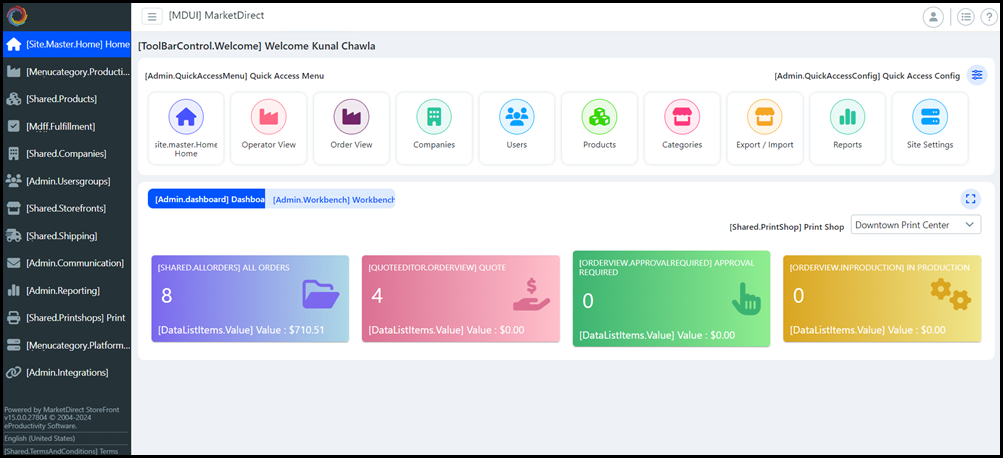Language Management—Customize Strings
Customize Strings
You can customize the text (strings) on your MarketDirect StoreFront
site. Customized text strings are “language overrides” (i.e., because
your custom text overrides, or replaces, the built-in language of the
site). For example, you could use customized strings to change all instances
of the word “gray” to “grey” on your site.
A “string” is a collection of letters (e.g., a word)
in language management. So the word “string” is itself a string of letters—s-t-r-i-n-g.
To
apply custom language overrides
1 Go
to Administration > Language Management.
2 Click
Customize Strings.
3 Overrides
are currently active: When checked, language overrides (i.e., any
custom text strings you have defined) are active on your site’s storefront.
4 In the Search Criteria
section, the Search By field lets
you search for a string to edit by Value
or Key.
To locate a single instance of a string to
override, use the Resource Tracker to find the string's resource ID key.
For information on how to do this, click .
Enabling the Resource Tracker will expose the resource ID keys for all
text on the interface. So after locating the resource ID key you are looking
for, return to the Administrator >
Language Management and uncheck the Enable
Resource Tracker checkbox.

● Value—Use this option if you want
to search for all occurrences of a word (such as “paper”). This can lead
to a long list of matches. If you select to search by Value, the Search Language pull-down list will
open.
● Key—Each word or label on the site
has a unique key. If you know the key of the word/string you are looking
for (i.e., if you used the Resource Tracker to find it), you can enter
it directly.
The note at the top of the page indicates
whether language overrides (i.e., custom text strings) are active or inactive
on your site. Clicking the link will open the Language
Overrides page (discussed in the following section).
5 Type (or paste)
the word, phrase, or key you want to replace with a custom word or phrase
in the text entry box  .
.
6 Check the appropriate
box/es to define search parameters:
● MarketDirect StoreFront
Words and Phrases—This will search for the default MarketDirect StoreFront text (as it
shipped).
● Custom Words and Phrases (added by me)—This
will search for any custom words or phrases you have added to replace
(or override) the default text.
7 If you are searching
by Value:
● Check
the Match Value Exactly box to
limit the search to exact matches of the word or phrase (an exact match
for “Catalog” would not return “catalog” because without capitalization
“catalog” is not an exact match).
● Select
a language (localized version) from the Search
Language pull-down list.
Text associated with the Invariant
Language (Invariant Country) setting cannot be edited (it is the system
default). The default language selected in the pull-down list is the language
currently used by the browser. If the word you are searching for is not
found in your first-choice language (e.g., English (United States)), try
the search again in the next less specific language (e.g., English). Search
the Invariant Language if there are no matches in English. In some cases,
you might have to run several searches to find the word or phrase you
are looking for. Also, if the search is too broad, the system will limit
the display of possible matches to 10. If the actual phrase is not found,
try a more specific search.
8 Click Search
to start the search.
● Result:
The results will be displayed beneath the Search
Criteria panel.
9 Once you locate
the instance of the word or phrase you want to customize by language (localized
version) then click Edit corresponding
to it.
● Result:
The text you searched for is displayed in all its language localized variants
in the editing grid.
The “key” for the instance of the
text you are editing is displayed above the editing grid: You
Are Editing... This is the Key that you would enter in a search
(instead of searching by Value) to locate this precise instance of the
text.
10 Click Edit
for the variant language to customize.
11 In the Comments
entry box, enter any comments about the customization.
12 In the text entry
box that opens in the Overridden
Text column, enter the custom word or phrase to override the existing
string.
13 Click Update
to save your change (or Cancel
to disregard it).
Result:
Your custom text will be displayed in the Overridden Text column and a
"Your changes have been updated" message will be shown at the
top of the page.
14 Repeat the steps
above if you want to customize the word or phrase in other localized versions.
See Also
● Language
Management
● Language
Support
● Resource
Tracker
 .
.